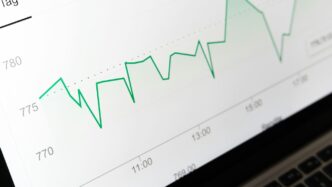In today’s fast-moving business world, just having a leadership title isn’t enough. You have to show real results. Leaders need to guide their teams and also push for new ideas and better performance. Using leadership KPIs helps companies measure these things in a clear way. These leadership kpis aren’t just numbers; they show how well a leader connects their team’s work to company goals, how good they are at keeping people engaged, and how quickly they can change when the market changes.
Key Takeaways
- Effective leadership is more than just managing tasks; it’s about having a clear vision and making smart choices that help the company reach its goals.
- Old ways of measuring leaders, like just looking at money or how many people leave, don’t always tell the whole story. We need better, more complete ways to measure things.
- Modern leadership kpis help companies deal with new business challenges by looking at things like team retention, employee happiness, and how quickly new ideas come out.
- To use leadership kpis well, you need to know what your main goals are, bring in information from different places, and make reports that help you make decisions.
- The future of measuring leadership will include how well leaders manage remote teams, how they handle environmental and social issues, and how they adapt to new technology.
Understanding Leadership Effectiveness
Before we jump into the nitty-gritty of KPIs and goals, let’s take a step back and really think about what "effective leadership" even means. It’s way more than just telling people what to do. It’s about having a vision, making smart calls, and actually getting stuff done.
Defining Effective Leadership
Effective leadership isn’t just about bossing people around; it’s about inspiring them. It’s about setting a clear vision and guiding your team toward achieving it. Think of it like this: a good leader is like a GPS, not just telling you where to go, but also helping you navigate the roadblocks along the way. It involves:
- Setting a clear direction and communicating it effectively.
- Inspiring and motivating team members to perform at their best.
- Making sound decisions, even under pressure.
- Creating a supportive and inclusive work environment.
Balancing Hard and Soft Skills
To be a truly great leader, you need a mix of both hard and soft skills. Hard skills are things like strategic planning and decision-making. Soft skills are things like communication, empathy, and being able to adapt to change. You can’t just be a numbers person or a people person; you need to be both. It’s a balancing act, for sure. Here’s a quick breakdown:
| Skill Type | Examples | Importance |
|---|---|---|
| Hard Skills | Strategic Planning, Financial Management | Help leaders make informed decisions and drive organizational performance. |
| Soft Skills | Communication, Empathy, Adaptability | Help leaders build strong relationships and create a positive work environment. |
The Role of Leadership KPIs
So, how do we know if a leader is actually effective? That’s where leadership KPIs come in. These metrics help us measure a leader’s impact on their team and the organization as a whole. But it’s not just about the numbers; it’s about using those numbers to understand what’s working and what’s not. We need manager effectiveness to understand how they can improve in clear and actionable ways.
Traditional Leadership Metrics and Their Limitations

Common Financial Metrics
When we talk about measuring leadership, the first things that usually come to mind are financial metrics. Things like revenue growth, profit margins, and cost reduction are often used to gauge a leader’s success. While these numbers are important, they don’t always tell the whole story. For example, a leader might hit revenue targets, but at what cost? Were employees overworked? Was long-term sustainability sacrificed for short-term gains?
Employee Turnover and Customer Satisfaction
Beyond the financials, employee turnover rates and customer satisfaction scores are also frequently used. High turnover might signal problems with leadership style or the work environment. Low customer satisfaction could indicate issues with product quality or service delivery. However, these metrics can be influenced by factors outside of a leader’s direct control. The job market might be hot, leading to more turnover regardless of leadership. Or, a competitor might launch a disruptive product, impacting customer satisfaction scores.
Why Traditional Metrics Fall Short
Traditional metrics often fail to capture the full scope of a leader’s impact. They tend to focus on lagging indicators, reflecting past performance rather than providing insights into future potential. They also often overlook the importance of soft skills, such as communication, empathy, and adaptability. A leader might be great at hitting targets, but terrible at motivating their team. This can lead to burnout, disengagement, and ultimately, a decline in performance. It’s like driving while only looking in the rearview mirror – you might see where you’ve been, but you won’t be able to anticipate what’s coming next. We need a more complete picture to truly assess manager effectiveness.
The Need for Modern Leadership KPIs
Things change, right? What worked last year might not cut it today, and that’s especially true in business. We can’t keep using the same old ways to see if our leaders are actually doing a good job. The world’s moving too fast. We need to adapt, and that means rethinking how we measure leadership.
Adapting to the Evolving Business Landscape
The business world isn’t standing still, and neither should our leadership metrics. Think about it: remote work, new technologies, and a bigger focus on things like diversity and inclusion. All of these things mean that leaders need a different set of skills than they used to. We need leadership KPIs that reflect these changes. It’s not just about the bottom line anymore; it’s about creating a good place to work, being adaptable, and keeping up with the times.
Holistic Approaches to Leadership Measurement
It’s time to look at the whole picture. We can’t just focus on the numbers. We need to think about things like:
- Employee Engagement: Are people actually happy and motivated?
- Innovation: Are leaders encouraging new ideas and ways of doing things?
- Adaptability: Can leaders handle change and uncertainty?
These are the things that really matter in the long run. Traditional metrics like revenue growth are important, but they don’t tell the whole story. We need a more complete way to measure Key Performance Indicators (KPIs) that takes into account all the different aspects of leadership.
Leveraging Data for Actionable Insights
Data is everywhere, but it’s useless if we don’t know what to do with it. The point of leadership KPIs isn’t just to collect numbers; it’s to use those numbers to make better decisions. We need to turn data into insights that leaders can actually use to improve their performance. This means:
- Creating clear, easy-to-understand reports.
- Identifying areas where leaders are struggling.
- Providing leaders with the tools and resources they need to improve.
If we can do that, then we can really start to see the impact of good leadership on the organization. It’s about using data to drive change and digital transformation, not just to measure it.
Key Leadership KPIs for Team Performance

Team Retention Rate
Okay, so, team retention rate. It’s pretty simple, right? It’s about keeping your people. A high retention rate usually means people are happy and don’t want to leave. But it’s more than just a feel-good metric. It directly impacts productivity and can save the company a ton of money on hiring and training new folks. If your team retention rate is low, it’s a big red flag that something’s wrong. Maybe it’s the workload, the lack of growth opportunities, or just a bad vibe. Whatever it is, you need to figure it out and fix it, fast. Here’s a quick look at how to interpret the numbers:
| Retention Rate | Interpretation |
|---|---|
| 90% + | Excellent – Keep doing what you’re doing! |
| 70-89% | Good – Room for improvement, but not critical. |
| Below 70% | Concerning – Immediate action needed. |
Employee Engagement Scores
Employee engagement scores are like a temperature check for your team’s morale. Are they just showing up, or are they actually invested in their work? There are a bunch of ways to measure this, from surveys to one-on-one chats. The key is to get honest feedback. If your engagement scores are low, don’t freak out. Use it as a chance to learn and make things better. Maybe people feel like their voices aren’t heard, or they don’t see how their work contributes to the bigger picture. Whatever it is, address it head-on. You can use tools to measure employee engagement and get a better understanding of the team’s morale.
Here are some things to consider when looking at engagement scores:
- Regularity: Are you checking in often enough?
- Anonymity: Do people feel safe giving honest feedback?
- Action: Are you actually doing something with the results?
Productivity and Innovation Metrics
Productivity and innovation metrics are all about measuring how much your team is getting done and how creative they are while doing it. It’s not just about churning out work; it’s about coming up with new ideas and ways to improve things. This can be tricky to measure, but it’s super important. Are people meeting their goals? Are they coming up with new products or processes? Are they finding ways to work smarter, not harder? If not, why not? Maybe they need more training, better tools, or just a little encouragement. It’s also important to see how leaders are driving performance within the team. Here are some ways to boost productivity and innovation:
- Set clear goals: Make sure everyone knows what they’re working towards.
- Provide resources: Give people the tools they need to succeed.
- Encourage experimentation: Let people try new things without fear of failure.
Measuring Leadership Impact on Organizational Goals
Aligning Leadership with Strategic Objectives
It’s easy to get lost in day-to-day tasks, but leadership’s main job is to make sure everyone’s rowing in the same direction. This means leaders need to clearly understand the organization’s goals and then translate those goals into actionable plans for their teams. If leadership isn’t aligned with the overall strategy, you’ll end up with teams working at cross-purposes, which is a recipe for disaster. Think of it like this: are leaders actively involved in setting the direction, or are they just reacting to whatever comes their way? We need to see leaders actively shaping the future, not just responding to it. One way to measure this is by tracking how well team goals support the broader organizational objectives. Are they directly contributing, or are they off on a tangent? Another is to assess how frequently leaders communicate the strategic vision to their teams. Regular updates and check-ins can help keep everyone on the same page. It’s about making sure everyone understands the ‘why’ behind their work.
Driving Performance and Innovation
Leaders aren’t just there to maintain the status quo; they’re there to push the boundaries and drive the organization forward. This means fostering a culture of innovation and empowering teams to take risks and experiment with new ideas. Are leaders actively encouraging their teams to think outside the box, or are they stifling creativity with rigid processes and procedures? One way to measure this is by tracking the number of new ideas generated by teams and the number of those ideas that are successfully implemented. Another is to assess the level of investment in research and development and the return on that investment. It’s about creating an environment where people feel safe to fail and learn from their mistakes. After all, innovation doesn’t happen without experimentation, and experimentation always involves some degree of risk. It’s also important to look at how leaders are measuring leadership performance and rewarding innovative behavior. Are they recognizing and celebrating successes, or are they only focusing on failures?
Assessing Adaptability to Market Changes
The business world is constantly changing, and leaders need to be able to adapt quickly to new challenges and opportunities. This means being able to anticipate market trends, identify emerging threats, and adjust their strategies accordingly. Are leaders actively monitoring the external environment, or are they caught off guard by unexpected events? One way to measure this is by tracking the organization’s response time to market changes and the effectiveness of those responses. Another is to assess the level of investment in training and development to ensure that employees have the skills they need to adapt to new technologies and business models. It’s about creating a culture of continuous learning and improvement, where people are always looking for ways to do things better. It’s also important to look at how leaders are driving executive leadership and communicating changes to their teams. Are they providing clear and consistent messaging, or are they creating confusion and uncertainty?
Implementing Leadership KPIs Effectively
Identifying Key Objectives and North Star Metrics
Okay, so you’re on board with using leadership KPIs. Great! But where do you even start? It’s easy to get lost in a sea of data, so the first step is to really nail down what you’re trying to achieve. What are your organization’s big goals? What does success look like? Once you know that, you can identify the "North Star" metrics that will guide your leadership team. These are the most important indicators of progress. For example, if your goal is to increase market share, your North Star metric might be customer acquisition cost or brand awareness. It’s about finding those metrics that truly reflect whether your leaders are moving the needle in the right direction.
Integrating Data from Various Sources
Alright, you’ve got your North Star metrics. Now comes the fun part: gathering the data. This isn’t always easy. You’ll probably need to pull information from different departments and systems. Think about HR data (employee engagement, turnover), sales data (revenue, customer satisfaction), and even marketing data (brand perception). The key is to create a system that brings all this information together in one place. This might involve using business intelligence tools, data analytics platforms, or even just a well-designed spreadsheet. The goal is to have a clear, unified view of leadership performance across the organization. For example, you might integrate data from performance reviews, 360-degree feedback, and project management software to get a complete picture of a leader’s impact. This integration is a key component for a successful digital transformation.
Generating Actionable Reports and Dashboards
So, you’ve got all this data. Now what? Well, it’s time to turn it into something useful. That means creating reports and dashboards that are easy to understand and that highlight key trends and insights. Think visual. Think simple. No one wants to wade through pages of numbers. A good dashboard should show you at a glance how your leaders are performing against their KPIs. It should also allow you to drill down into the data to understand why they’re performing the way they are. The reports should be regular and consistent, so everyone knows what to expect. And most importantly, they should be actionable. What decisions can you make based on this information? What changes can you implement to improve leadership effectiveness? Here’s an example of how you might structure a leadership KPI dashboard:
| KPI | Target | Actual | Status | Trend |
|---|---|---|---|---|
| Employee Engagement | 80% | 75% | Off Track | Decreasing |
| Team Retention Rate | 90% | 92% | On Track | Increasing |
| Project Completion Rate | 95% | 90% | At Risk | Stable |
Future Trends in Leadership KPI Measurement
Remote Leadership Effectiveness
Remote work is here to stay, and that means leadership has to adapt. It’s not enough to just check in with people over Zoom. We need to figure out how to measure if leaders are actually effective when they’re managing teams from afar. This involves looking at things like communication, trust, and how well remote teams collaborate. Are people feeling connected? Are they getting the support they need? These are the questions we need to answer with the right KPIs. For example, we can track the frequency and quality of interactions, the speed of decision-making, and the overall sense of community within the team. It’s a whole new ballgame, and the old rules don’t apply.
Sustainability and Social Responsibility KPIs
More and more, people care about whether companies are doing good in the world. It’s not just about profits anymore. Leaders are under pressure to show they’re taking corporate social responsibility seriously. That means we need KPIs that measure things like a company’s environmental impact, its commitment to diversity and inclusion, and its ethical sourcing practices. Are leaders setting goals for reducing carbon emissions? Are they creating a more diverse and inclusive workplace? Are they ensuring their supply chains are free from exploitation? These are the kinds of things we need to track. It’s about holding leaders accountable for more than just the bottom line.
The Impact of Digital Transformation
Technology is changing everything, and leadership is no exception. Leaders need to be able to navigate digital transformation and use data to make better decisions. That means we need KPIs that measure things like a leader’s ability to adopt new technologies, their data literacy, and their ability to drive innovation. Are leaders embracing new tools and platforms? Are they using data to identify opportunities and solve problems? Are they fostering a culture of experimentation and learning? These are the questions we need to answer. The future of leadership is all about being tech-savvy and data-driven.
Wrapping It Up
So, we’ve talked a lot about how important it is to pick the right ways to measure how well leaders are doing. It’s not just about the usual money stuff anymore. Good leaders today need to be able to change with the times, keep their teams happy, and make sure everyone is working towards the same goals. By looking at a mix of different numbers and information, companies can really see what’s working and what’s not. This helps leaders get better at their jobs and makes the whole company stronger. It’s all about using smart information to help everyone win.
Frequently Asked Questions
What are Leadership KPIs?
Leadership KPIs are like report cards for leaders. They are special numbers and facts that show how well a leader is doing their job. They help us see if a leader is helping their team and company reach its goals.
Why are traditional ways of measuring leaders not enough anymore?
Old ways of checking leaders often just looked at money stuff, like how much profit was made or how much was spent. But these don’t tell the whole story. A company might make a lot of money because of other things, not just the leader. New KPIs look at more things, like how happy employees are or how well teams work together.
How do modern Leadership KPIs help organizations?
Modern KPIs help leaders see what’s really working and what’s not. They give a bigger picture than just money. They also help leaders change and get better as the world of business changes, like with more people working from home.
What are some important Leadership KPIs for team success?
Some good KPIs for how teams are doing include how many people stay on the team (Team Retention Rate), how happy and involved employees are (Employee Engagement Scores), and how much good work the team gets done (Productivity Metrics).
How can leaders show they are helping the company’s big goals?
Leaders can show they’re helping the company by making sure their team’s goals match the company’s main goals. They can also show how they help new ideas come to life and how easily their team can change when things are different in the market.
What’s the best way to start using Leadership KPIs?
To use KPIs well, first, figure out what’s most important for your company to achieve. Then, gather information from different places, like surveys and work tools. Finally, make easy-to-read reports that show what’s happening and what needs to be done next.














